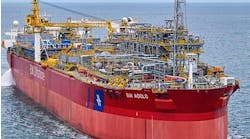Neil Douglas, Vetco Gray Ltd.
The Snøhvit project in the Norwegian sector of the North Sea is a milestone in offshore oil and gas development. It will be the first Norwegian and European production and export facility for liquefied natural gas (LNG).
The field lies 140 km from the coast of Northern Norway, and its production will be piped to a receiving and liquefaction plant on Melkøya island outside Hammerfest. This field is the first development in the environmentally sensitive Barents Sea. It is located within the Arctic Circle and 1,000 km north of the Norne field, currently the most northerly producing field offshore Norway.
After processing and liquefaction, LNG will be shipped in special carriers to markets in Spain and the USA. Approximately 70 consignments are due to be exported annually over the field life of almost 30 years.
Snøhvit is the first Norwegian offshore development with no surface-piercing installations on the field. The pipeline carrying production from the subsea installations to Melkøya is 145 km (90 mi) long - a world record distance for piping an unprocessed wellstream. The associated subsea control system will also be a world record for long-distance tie-back. The ultimate field development, which includes the reserves of Askeladd, has resulted in a control system that has a total offset capability of 220 km (136 mi).
The primary technology gaps that had to be closed to develop the field were the long offset control and compact, efficient LNG plant, together with long offset multiphase flow. In combination, these technologies allow subsea development without the need for a conventional surface structure.
The first gas discovery was made in 1981, and a total of 16 exploration wells have been drilled in the area. In May 2002, Statoil obtained approval from the Norwegian government to develop the field. By June 12, construction work had started on Melkøya with first production scheduled for 2006.
The subsea development envisions some 21 production wells and a carbon dioxide disposal well. This disposal well greatly reduces environmental impact from the development (700,000 metric tons of reservoir CO2 is reinjected each year). The focus on environmental impact is due to the environmentally sensitive nature of the area and also that it is an important fisheries area.
Clearly, the use of a subsea development with remote control from shore is a cost-effective solution that ensures safe shipping routes and is in line with Norwegian practice; the subsea templates are designed to be over-trawlable and the pipeline routes are also chosen so as to reduce their possible hindrance to fisheries.
Recoverable reserves are estimated at 190 bcm of LNG, 113 MMbbl of condensate and 5.1 million metric tons of LPG. The field concept is sized for a well stream production of 20.8MSm3/sd. When production gets into full swing in 2006, the gas produced will represent a large contribution to Norway’s total gas exports.
Field development
Development of the Snøhvit reservoirs is based on horizontal trees with recoverable choke bridge modules mounted on four-slot templates, located at appropriate points on the seabed above the reservoirs. Connections between the tree/choke bridge systems and the infield flowline are through a manifold located on the template. For the phase 1 Snøhvit and Albatross development, there are four templates designated D, E, F, and N. Templates D, E and N are gas production, while template F is a dual header gas production and CO2 injection template with a single slot dedicated to CO2 injection.
For phase 1, only three slots on each of the D, E, and N templates will be populated while only the CO2 injection slot will be populated on the F template.
For future phases, a further three templates will be installed at the Askeladd reservoir, designated J, K, and L in addition to further population of the existing D, E, F, and N templates.
Subsea control system
The Vetco Gray control system provided for the Snøhvit field uses a hybrid electrical and optical communications system, and electrical and hydraulic power to control the subsea facilities via a main umbilical connected between shore-based control equipment and the subsea system. The Snøhvit hydraulic system is a dual redundant LP system. All HP supplies are generated at the Subsea Control Module (SCM) by means of High Pressure Intensifier units located within each SCM.
The hydraulic system is an open loop vent to the sea and uses an environmental friendly control fluid.
Subsea, the main umbilical terminates at a central distribution unit (CDU), from which power and communications are further distributed to the templates via infield umbilicals.
The main challenge for the control system is the length of the main umbilical between the onshore control system equipment and CDU. This has necessitated use of optical fiber communications techniques in order to achieve the control and monitoring response and update rates.
Should the umbilical optical system fail, a back-up communications on power system is available - operating using the umbilical power conductors at a reduced communications rate.
Should total umbilical failure occur, a back-up intervention control system is provided. This system will replace the main umbilical by providing optical, electrical and hydraulic services from a vessel to be located directly above the CDU and connected via a dynamic umbilical with satellite communications links to the onshore control facility.
The project requires significant subsea instrumentation, including conventional christmas tree instrumentation and other instruments located on the choke-bridge module. The tree instrumentation includes various pressure and temperature sensors for the annulus, production bore and downhole, as well as a hydrocarbon leak detector. The choke-bridge module requires high accuracy pressure and temperature sensors, various sand detectors, wet gas and MEG flowmeters, and a scale inhibitor metering valve.
There are also pipeline corrosion monitoring devices located at 1 km and 17 km from the upstream end of the flowline with a third unit being installed in the onshore section of the flowline.
The water depth is a relatively modest 350 m but the design life of 30 years is slightly longer than average for the subsea controls industry.
The challenges of long-range, electrical power supply are many and include minimizing the copper content of the umbilical and producing a subsea transformer of a size that can be conveniently packaged in standard retrievable subsea modules. The solution adopted for Snøhvit is a 3-phase, 3 kV link, with a subsea, step-down transformer at the CDU. Single-phase power is distributed to the subsea control modules at 600 v.
The overall architecture of the control system is a dual-duplex redundant system. For each channel the bi-directional, full duplex fibers and modems are replicated. They are backed up with low-speed communications superimposed on the 3-phase power supply, and the whole system is then duplicated by a second channel. The so-called backup intervention control system (BUICS) can intervene from a vessel-of-opportunity and connect directly into the power and communications distribution module (PCDM) on the CDU.
Each redundant PCDM contains two off optical modems, which receive data from a dedicated fiber. The modems demodulate the fiber optic data and pass it in electrical format to a communications router where it is buffered and presented to the high-speed copper modems for onward transmission to the template.
Packaging of the new technology in the PCDM is surprisingly conventional. The module is externally identical to the main subsea control module for the tree, and uses the same running tool to retrieve and re-install if necessary. The module contains the 10-kVA transformer for voltage step-down and communication modules enclosed in conventional pressure-isolating vessels, together with another module for power monitoring, protection and switching.
All connection between the subsea system and the onshore components of the control system is via a single continuous main umbilical with no intermediate connections or booster stations.
The main umbilical has two of 12 fiber conduits, one channel A, the other allocated to channel B. Within each channel, four fibers are allocated to Snøhvit/Albatross, four to Askeladd, and four are provided as spares. Of the four allocated to each field, only two are used, one allocated to each of the two modems in each PCDM. The unused fibers are taken through the distribution system to the connectors in the PCDM and could be used at a later stage.
The communications system employed provides a high throughput capability. Each optical modem has a line bit rate of 20 Mbits/sec (usable rate is 10 Mbits/sec). Data routers located both onshore and subsea in the PCDMs enable up to eight virtual channels to be multiplexed onto the optical communications links.
Subsea, three of these channels are routed to three HSCMs - each dedicated to communicating via one of the electrical power phases. The HSCMs communicate via the power lines in the infield umbilicals with the tree mounted SCMs. The HSCMs use a spread-spectrum modulation technique. The technology ensures a bit rate on the powerline of 268 kbits/sec. This bit rate is reduced to a usable data rate of 115 kbits/sec once the adaptive equalization and forward error correction algorithms have been accommodated.
The technology and modulation schemes ensure a bit error rate of better than 1 in 109. Communications are maintained with signals attenuated by as much as 90 dB. One other feature of this modem is that because its operating bandwidth is outside other subsea communications systems, it can be operated “on top” (superimposed) of existing subsea systems in order to enhance data transmission capability.
Gaps, development, qualification
One significant aspect of Snøhvit is the provision of high control availability over an extremely long distance. As described previously, long-range communication without repeaters and relatively high data requirements dictated that a fiber-optic link be used as the principal means of communication from the subsea location to shore. The long range also led to adoption of a high voltage, three-phase power transmission system operating at 3 kV.
Some years ago, Statoil embarked on a review of available technology, which lead to funding for new equipment. In relation to the control system, this new equipment included:
•Long-range communications without repeaters
• Long-range 3kV power supply
• High data rate requirements
• HV electrical and fibre-optic wet-mate connectors
Project status
The development and qualification of communication modules is complete, with the control system extended FAT currently being undertaken.
The subsea structures were successfully installed in July 2004. The installation contractor, Aker Marine, completed the installation of four well templates (approx 260 metric tons each), a 430-metric ton pipeline end module, and a 270-metric ton CDU, all within a single calendar month. Three of the templates were installed on the Snøhvit reservoir, with the fourth being installed on Albatross.
The Vetco Gray control system design for the Snøhvit project has addressed and overcome some difficult technical challenges and represents a significant advance for long offset control.
A number of technologies have been combined to provide the necessary safe and reliable long offset control system.
Fiber-optic communications modems have been developed together with a 3-phase, 3-kV power delivery system with backup communication superimposed on the power lines. In addition, as we have noted, a local high-speed, communication-on-power system is used to provide communication and power to the subsea wells and a communication router implements the communication switching and prioritization.
These technologies provide a significant stepping-stone for other subsea-to-beach projects in the future.•





